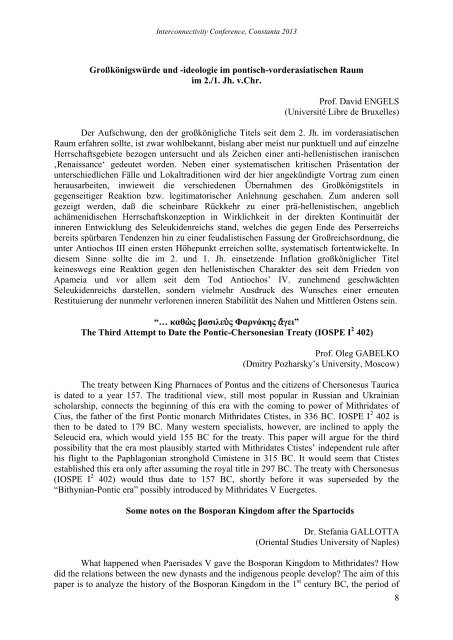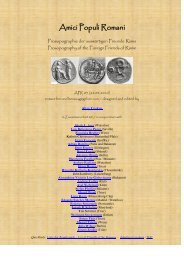1 Lokales und römisches Bürgerrecht: Das Beispiel der Iulii von ...
1 Lokales und römisches Bürgerrecht: Das Beispiel der Iulii von ...
1 Lokales und römisches Bürgerrecht: Das Beispiel der Iulii von ...
You also want an ePaper? Increase the reach of your titles
YUMPU automatically turns print PDFs into web optimized ePapers that Google loves.
Interconnectivity Conference, Constanta 2013<br />
Großkönigswürde <strong>und</strong> -ideologie im pontisch-vor<strong>der</strong>asiatischen Raum<br />
im 2./1. Jh. v.Chr.<br />
Prof. David ENGELS<br />
(Université Libre de Bruxelles)<br />
Der Aufschwung, den <strong>der</strong> großkönigliche Titels seit dem 2. Jh. im vor<strong>der</strong>asiatischen<br />
Raum erfahren sollte, ist zwar wohlbekannt, bislang aber meist nur punktuell <strong>und</strong> auf einzelne<br />
Herrschaftsgebiete bezogen untersucht <strong>und</strong> als Zeichen einer anti-hellenistischen iranischen<br />
‚Renaissance„ gedeutet worden. Neben einer systematischen kritischen Präsentation <strong>der</strong><br />
unterschiedlichen Fälle <strong>und</strong> Lokaltraditionen wird <strong>der</strong> hier angekündigte Vortrag zum einen<br />
herausarbeiten, inwieweit die verschiedenen Übernahmen des Großkönigstitels in<br />
gegenseitiger Reaktion bzw. legitimatorischer Anlehnung geschahen. Zum an<strong>der</strong>en soll<br />
gezeigt werden, daß die scheinbare Rückkehr zu einer prä-hellenistischen, angeblich<br />
achämenidischen Herrschaftskonzeption in Wirklichkeit in <strong>der</strong> direkten Kontinuität <strong>der</strong><br />
inneren Entwicklung des Seleukidenreichs stand, welches die gegen Ende des Perserreichs<br />
bereits spürbaren Tendenzen hin zu einer feudalistischen Fassung <strong>der</strong> Großreichsordnung, die<br />
unter Antiochos III einen ersten Höhepunkt erreichen sollte, systematisch fortentwickelte. In<br />
diesem Sinne sollte die im 2. <strong>und</strong> 1. Jh. einsetzende Inflation großköniglicher Titel<br />
keineswegs eine Reaktion gegen den hellenistischen Charakter des seit dem Frieden <strong>von</strong><br />
Apameia <strong>und</strong> vor allem seit dem Tod Antiochos‟ IV. zunehmend geschwächten<br />
Seleukidenreichs darstellen, son<strong>der</strong>n vielmehr Ausdruck des Wunsches einer erneuten<br />
Restituierung <strong>der</strong> nunmehr verlorenen inneren Stabilität des Nahen <strong>und</strong> Mittleren Ostens sein.<br />
“… καθὼς βασιλεὺς Φαρνάκης ἄγει”<br />
The Third Attempt to Date the Pontic-Chersonesian Treaty (IOSPE I 2 402)<br />
Prof. Oleg GABELKO<br />
(Dmitry Pozharsky‟s University, Moscow)<br />
The treaty between King Pharnaces of Pontus and the citizens of Chersonesus Taurica<br />
is dated to a year 157. The traditional view, still most popular in Russian and Ukrainian<br />
scholarship, connects the beginning of this era with the coming to power of Mithridates of<br />
Cius, the father of the first Pontic monarch Mithridates Ctistes, in 336 BC. IOSPE I 2 402 is<br />
then to be dated to 179 BC. Many western specialists, however, are inclined to apply the<br />
Seleucid era, which would yield 155 BC for the treaty. This paper will argue for the third<br />
possibility that the era most plausibly started with Mithridates Ctistes‟ independent rule after<br />
his flight to the Paphlagonian stronghold Cimistene in 315 BC. It would seem that Ctistes<br />
established this era only after assuming the royal title in 297 BC. The treaty with Chersonesus<br />
(IOSPE I 2 402) would thus date to 157 BC, shortly before it was superseded by the<br />
“Bithynian-Pontic era” possibly introduced by Mithridates V Euergetes.<br />
Some notes on the Bosporan Kingdom after the Spartocids<br />
Dr. Stefania GALLOTTA<br />
(Oriental Studies University of Naples)<br />
What happened when Paerisades V gave the Bosporan Kingdom to Mithridates? How<br />
did the relations between the new dynasts and the indigenous people develop? The aim of this<br />
paper is to analyze the history of the Bosporan Kingdom in the 1 st century BC, the period of<br />
8



